Scotch Macaskill's Wildlife Blog
IMPORTANT: Please note that from April 2009 this Blog's Web address changed as a result of a switch in the blogging platform we use. It's still an integral part of the Wildlife Pictures Online website and, we hope, will continue providing entertaining and enjoyable content in the form of wildlife images, news, views and information.
For the most recent posts, links, and other resources, please visit the new Wldlife Photography Blog.
|
New Calendar Range
February 4, 2007
|
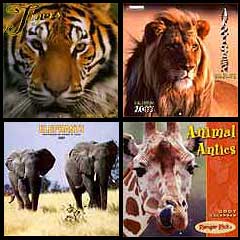 Although our initial selection of 2007 wildlife and nature calendars sold out sooner than expected, we're now featuring products from specialist calendar supplier Calendars.com, a reliable and well-established North American company that offers a superb and diverse selection of wall and desktop calendars.
Although our initial selection of 2007 wildlife and nature calendars sold out sooner than expected, we're now featuring products from specialist calendar supplier Calendars.com, a reliable and well-established North American company that offers a superb and diverse selection of wall and desktop calendars. Their range of subjects - including wildlife, animals, and nature - is vast, so there's every likelihood you'll find exactly what you want. Please visit our 2007 Wildlife Calendars page to browse and see what's on offer.
|
Today's Picture: Chimpanzee Close-up
February 4, 2007
|
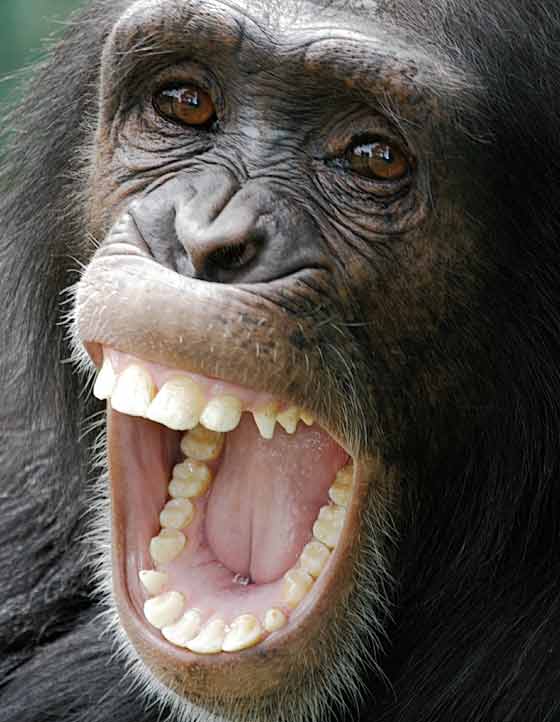
Photo Details: Chimpanzee (Pan troglodytes) up close, looking like it's having a big laugh, but in reality having a big yawn, Natal Zoological Gardens, KZN, South Africa.
Camera: Canon EOS 400D; Lens: Canon 100-400 IS Zoom; Focal Length: 400mm; Shutter speed: 1/50; Aperture: f8; ISO: 400.
Please Note: Pictures displayed on this blog are copyright protected. View them online, enjoy them, but kindly do not use them for anything else. Should you wish to purchase an image or require clarification on use, please contact me.
|
Today's Picture: Impala Running for Cover
February 13, 2007
|
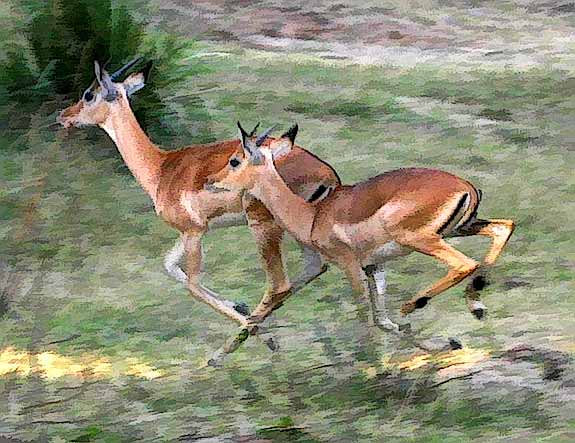
Photo Details: Young impala rams (Aepyceros melampus) running for cover, Lower Zambezi National Park, Zambia.
Camera: Canon EOS Digital Rebel; Lens: Canon 100-400 IS Zoom; Focal Length: 160mm; Shutter speed: 1/200; Aperture: f7.1; ISO: 400.
Additional Info: We were on an afternoon game-drive in the Lower Zambezi National Park when a small group of impala took flight at our approach. They were some distance away and as they ran through a dry water course, I took a few shots.
Pictures of running animals can often look awkward and unco-ordinated, depending on the angle of the limbs at the moment of capture. Because of lag in human reactions and camera operation, it's
virtually impossible to press the shutter at the critical moment when photographing fast-moving animals. So photogaphers tend instead to rely on the camera's continuous shooting mode and
keep the finger on the shutter, hoping for the best.
Although I wasn't using that technique (my camera gear isn't sophisticated enough), the picture above of the two young impala - at least to me - captures their speed and grace,
even when in flight. Unfortunately the animals filled only a tiny portion of the frame, necessitating a radical crop. After some fiddling in Photoshop with colours and contrast,
the image started looking quite grainy and "painterly". So I decided to emphasise that look, using a program called Buzz Simplifier.
Am I a frustrated wildlife artist? No, I don't think so, although it would be awesome to have the talent. It's more a case of boredom with wildlife portraits and static images which, in the majority of cases,
is what most of us end up with after a few days in a game reserve or wildlife sanctuary.
|
Today's Picture: Galloping Zebra
February 19, 2007
|
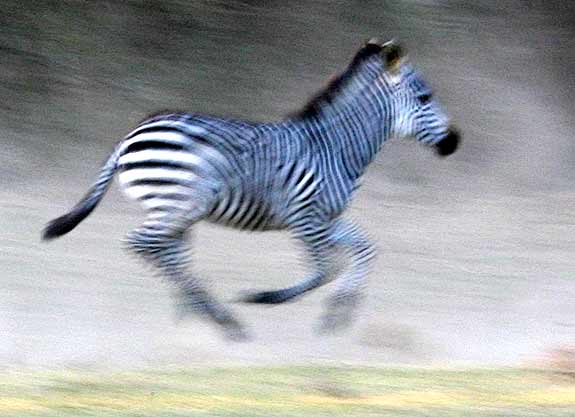
Photo Details: Plains Zebra (Equus burchelli) galloping across open grassland, Lower Zambezi National Park, Zambia.
Camera: Canon EOS Digital Rebel; Lens: Canon 100-400 IS Zoom; Focal Length: 160mm; Shutter speed: 1/40; Aperture: f9; ISO: 400.
Additional Info: Following on from the previous photograph (impala rams running for cover), this image also depicts animal movement. It's also a crop from a larger image, but there's been no digital manipulation other than adjusting brightness and contrast.
However, I did use a relatively slow shutter speed (1/40th) and panned the camera, following the moving animal, to create the blurred background and, inevitably with this deliberate "motion-blur" technique, some blurring of the subject itself.
"Motion-blur" provokes mixed reactions. When it works, the sense of speed and movement is a lot more effective - in my opinion - than freezing the action with a very fast shutter speed. This is specially so in sports photography.
But others see this type of photograph simply as blurry and unsharp. Wildlife photographer Darryl Balfour says that even National Geographic magazine, which often includes impressionistic, blurred images in its pages, doesn't escape criticism, drawing comments like:
"My granny could take photographs like that" and "I normally throw those shots away before anyone sees them".
Panning the camera and using a slow shutter speed requires practice and results are not predictable - but it's fun to try and gives one additional photo opportunities when the light is too poor to use faster shutter speeds.
|
Today's picture: Lioness Stretching
February 20, 2007
|
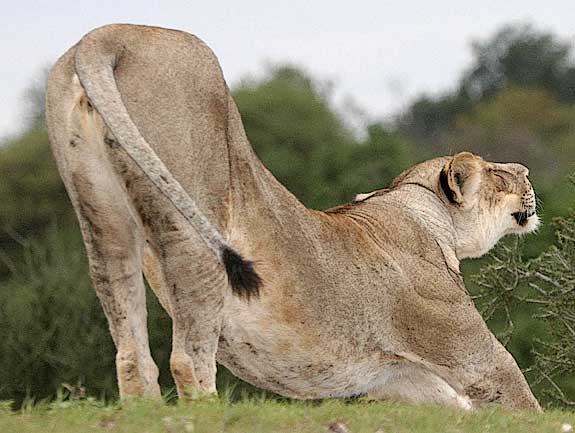
Photo Details: Lioness (Panthera leo) extends her front legs and arches her back as she has a good stretch following an afternoon nap, Mashatu Game Reserve, Tuli Block, Botswana.
Camera: Canon EOS 350D; Lens: Canon 100-400 F5.6 IS zoom; Focal Length: 190mm; Shutter Speed: 1/200; Aperture: f5; ISO: 800
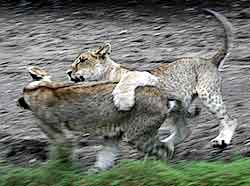
Additional Info: The picture was taken in late afternoon - after 6pm - as a pride of lions started stirring. They'd been resting, as lions do, for most of the day. But now, with the sun below the horizon and the summer heat dissipating, it was clearly time for action. Two cubs began practising their attacking skills on each other (right), while the adults started moving around, apparantly readying themselves for an early evening patrol in search of the next meal.
It's one of the harsh realities of wildlife photography that so much of the best action takes place at night, or in poor light once it starts getting cooler. Fortunately digital cameras have given photographers a huge boost by allowing us to crank up the ISO. In the example above, I was able to boost the ISO to 800, which allowed a shutter speed of 1/200, even in the fading light. But for the cub photo taken only a few minutes later, even at 800 ISO the fastest shutter speed I could get was 1/60 (at max zoom of 400mm and aperture F5.6), giving a somewhat blurred picture.
|
Today's Picture: Leopard Looking Down
February 27, 2007
|
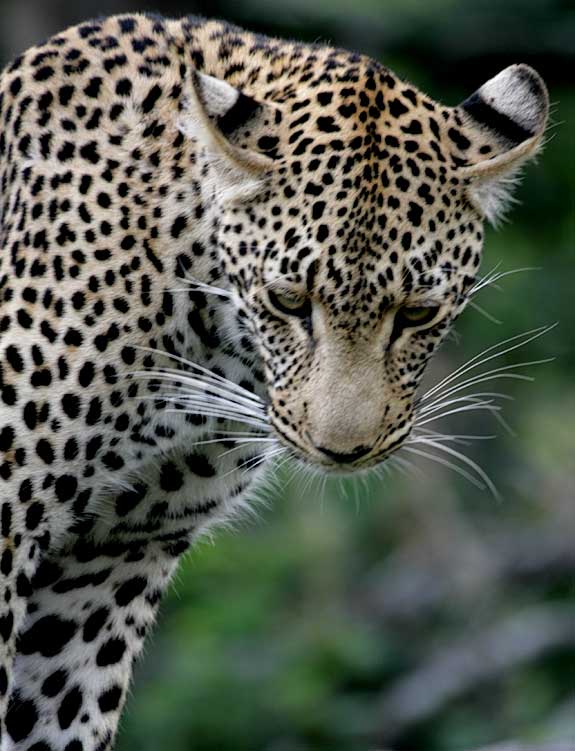
Photo Details: Leopard (Panthera pardus) on tree stump looking down, Elephant Plains Game Reserve, Sabi Sands, South Africa.
Camera: Canon EOS 400D; Lens: Canon 100-400 IS Zoom; Focal Length: 400mm; Shutter speed: 1/100; Aperture: f5.6; ISO: 200.
Please Note: Pictures displayed on this blog are copyright protected. View them online, enjoy them, but kindly do not use them for anything else. Should you wish to purchase an image or require clarification on use, please contact me.
|
| |
| Back to top of page
|
|
Previous Entries
By Month
By Category
My Original Blog
2005 Entries
2004 Entries
2003 Entries
Who Am I?
Brief Bio
|







